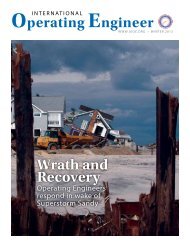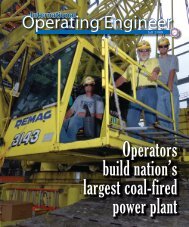Summer 2009 - International Union of Operating Engineers
Summer 2009 - International Union of Operating Engineers
Summer 2009 - International Union of Operating Engineers
You also want an ePaper? Increase the reach of your titles
YUMPU automatically turns print PDFs into web optimized ePapers that Google loves.
safety & Health News<br />
Report cites construction fatalities, <strong>of</strong>fers recommendations<br />
This report summarizes fatalities related to construction<br />
machinery in Washington State from 1998 to<br />
2008. The data was compiled by the Washington<br />
State Fatality Assessment and Control Evaluation (FACE)<br />
Program. This report includes construction machinery incidents;<br />
construction vehicles such as dump trucks or other<br />
motor vehicles were not included.<br />
Between 1998 and 2008, 33 workers died in construction<br />
machinery incidents in Washington State, 16 were machinery<br />
operators and 17 were workers on foot. Operators were killed<br />
most frequently in backhoe/trackhoe incidents, while workers<br />
on foot were killed most frequently in excavator incidents.<br />
Furthermore, machinery operators were predominately<br />
involved in fatal roll-over incidents, while workers on foot<br />
were either mainly struck by machinery or other objects. The<br />
majority <strong>of</strong> the operators killed were not wearing seat belts or<br />
restraints.<br />
Prevention Measures<br />
to Protect Workers<br />
The following are some steps that should be taken by employers,<br />
equipment operators and others to protect workers<br />
from injury while working with construction machinery:<br />
Site Set-Up<br />
• Contact local utilities and other responsible parties to<br />
locate overhead and underground utility lines before<br />
beginning work. Avoid working near overhead power<br />
lines. If you must work near them, develop a plan to<br />
avoid contact.<br />
• Do not permit hydraulic excavators or backhoes to be<br />
operated on grades steeper than those specified by the<br />
manufacturer.<br />
• Make sure that workers position machinery at a safe<br />
distance from excavations such as trenches.<br />
Equipment Operators<br />
• Train equipment operators in the proper use <strong>of</strong> the<br />
equipment they are assigned to operate. Be sure to follow<br />
manufacturers’ specifications and recommendations.<br />
• Continually evaluate safety programs to address changing<br />
conditions at the worksite.<br />
• Clearly identify and label all machine controls and make<br />
sure that the manufacturers’ safety features are working.<br />
• Install and maintain equipment attachments and their<br />
operating systems according to manufacturers’ specifications.<br />
• Train operators to conduct visual and operational checks<br />
on all machine systems and operating controls before<br />
working the machine.<br />
• Make frequent visual inspections <strong>of</strong> quick-disconnect<br />
systems—especially after changing attachments.<br />
• Use the ROPS and seat belts supplied by the manufacturer.<br />
Do not remove the ROPS.<br />
• Do not exceed load capacities when lifting materials.<br />
• Instruct operators to lower the boom to a safe position<br />
with the bucket on the ground and turn <strong>of</strong>f the machine<br />
before stepping <strong>of</strong>f for any reason.<br />
Other Site Workers<br />
• Train site workers to recognize and avoid unsafe conditions<br />
and to follow required safe work practices that<br />
apply to their work environments.<br />
• Make all workers on the site aware <strong>of</strong> the machines’ established<br />
swing areas and blind spots before the operator<br />
works the machine. Keep workers on foot outside<br />
these areas by marking them with rope, tape, or other<br />
barriers.<br />
• Before each work shift begins, review and confirm<br />
communications signals between machine operators<br />
and workers on foot.<br />
• Instruct machine operators to keep the bucket as close<br />
to the ground as possible when workers are attaching<br />
loads for hoisting.<br />
• Do not allow workers to stand under suspended loads<br />
or suspended machine components such as the boom,<br />
arm, or bucket.<br />
• Use spotters or signal persons around operating equipment<br />
when necessary.<br />
• Never permit workers to ride in or work from excavator<br />
or backhoe loader buckets.<br />
The full Construction Machinery Fatalities report<br />
generated by Washington State can be found on the<br />
Washington State Department <strong>of</strong> Labor & Industries<br />
website at http://www.lni.wa.gov/Safety/Research/<br />
Face/Files/ConstructionMachineryFatalities.pdf<br />
18<br />
i n t e r n at i o n a l operating e n g i n e e r













